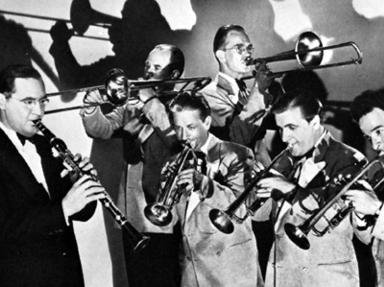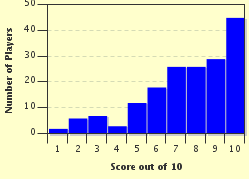Quiz Answer Key and Fun Facts
1. "Don't you know little fool, you never can win
Use your mentality, wake up to reality
But each time I do, just the thought of you
Makes me stop before I begin"
The lines come from a 1936 Cole Porter lyric. What song was it?
2. One of Irving Berlin's most famous compositions contained these lines;
"Never saw the sun shining so bright
Never saw things going so right
Noticing the days hurrying by
When you're in love, my how they fly"
Which of the following songs was it?
3. A Rodgers and Hart composition topped the U.S. charts twice - once by Glen Gray in 1935 then by The Marcels in 1961. With this lyrical hint, you should have little problem identifying the song.
"And then there suddenly appeared before me
The only one my arms will ever hold
I heard somebody whisper, 'Please adore me',
And when I looked, the moon had turned to gold"
4. Words by Johnny Mercer, music by Harold Arlen, what was the name of their song that reached Number One on the charts of the day in 1942? Here's a sample of the lyric.
"My mama done tol' me,
When I was in knee pants
My mama done tol' me, Son!
A woman'll sweet talk
And give ya the big eye"
5. I'd say that most people have no knowledge of a person named Walter Donaldson but everyone has heard his music. Among his biggest hits, in collaboration with lyricist George Whiting, was this little ditty that was a 13 week chart topper for Gene Austin in 1927. What song featured this slice of lyric?
"You'll see a smilin' face, a fireplace, a cozy room
A little nest that nestles where the roses bloom
Molly and me, and the baby makes three"
6. A musical researcher in 2004 determined that over 33,000 cover versions of this song have been recorded since it was composed in 1934 so, without question, you've heard it many times. There aren't many words in the lyric and I'm going to give you one quarter of them as a clue. That should be ample for you to identify it.
"Your daddy's rich and your mamma's good lookin'
So hush little baby don't you cry"
7. "You leave the Pennsylvania Station 'bout a quarter to four
Read a magazine and then you're in Baltimore
Dinner in the diner, nothing could be finer
Than to have your ham an' eggs in Carolina"
These lines come from one of the many contributions to the Great American Songbook by composer Harry Warren, this time with the lyric being contributed by Mack Gordon. Can you name it?
8. Jerome Kern was yet another composer who initially specialized in providing scores for the live theatre on Broadway and later for the movies. Below is an example of his handiwork with lyric provided by Otto Harbach. What song was it?
"They asked me how I knew my true love was true
I of course replied something here inside
Cannot be denied"
9. If I asked what the most popular song written by Isham Jones and Gus Kahn was, most people wouldn't have the foggiest notion. But if I ask what is the title of the song represented by the following segment of lyric, I'm betting that many, if not most of you can come up with the right answer. Can you?
"Some others I've seen might never be mean
Might never be cross or try to be boss
But they wouldn't do
For nobody else, gave me a thrill
With all your faults, I love you still"
10. "Sometimes I wonder why I spend
The lonely nights dreaming of a song
The melody haunts my reverie
And I am once again with you
When our love was new
And each kiss an inspiration"
This lyrical passage is from one of the most recorded and revered songs of the 20th Century. The music was composed by Hoagy Carmichael in 1927 and the lyrics were added in 1929 by Mitchell Parish with Carmichael's support and input. Can you identify it?
Source: Author
maddogrick16
This quiz was reviewed by FunTrivia editor
agony before going online.
Any errors found in FunTrivia content are routinely corrected through our feedback system.

